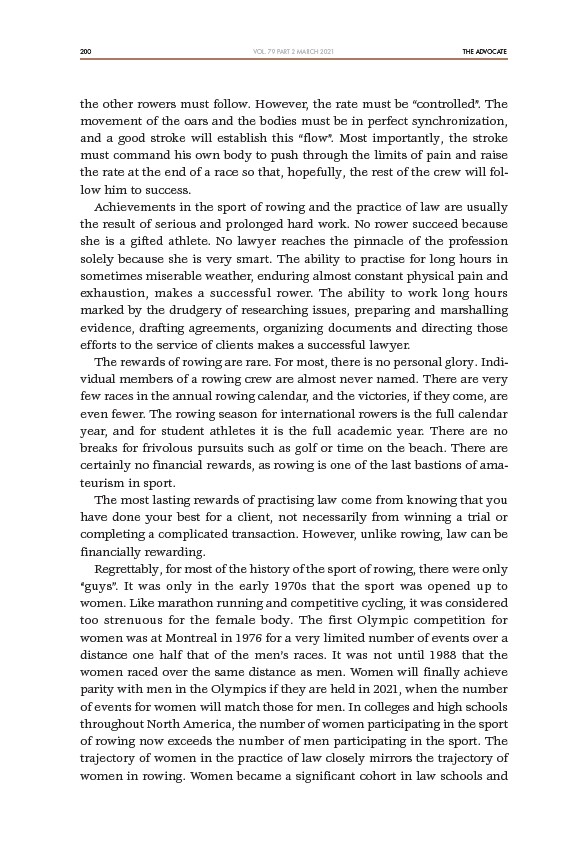
200 THE ADVOCATE
VOL. 79 PART 2 MARCH 2021
the other rowers must follow. However, the rate must be “controlled”. The
movement of the oars and the bodies must be in perfect synchronization,
and a good stroke will establish this “flow”. Most importantly, the stroke
must command his own body to push through the limits of pain and raise
the rate at the end of a race so that, hopefully, the rest of the crew will follow
him to success.
Achievements in the sport of rowing and the practice of law are usually
the result of serious and prolonged hard work. No rower succeed because
she is a gifted athlete. No lawyer reaches the pinnacle of the profession
solely because she is very smart. The ability to practise for long hours in
sometimes miserable weather, enduring almost constant physical pain and
exhaustion, makes a successful rower. The ability to work long hours
marked by the drudgery of researching issues, preparing and marshalling
evidence, drafting agreements, organizing documents and directing those
efforts to the service of clients makes a successful lawyer.
The rewards of rowing are rare. For most, there is no personal glory. Individual
members of a rowing crew are almost never named. There are very
few races in the annual rowing calendar, and the victories, if they come, are
even fewer. The rowing season for international rowers is the full calendar
year, and for student athletes it is the full academic year. There are no
breaks for frivolous pursuits such as golf or time on the beach. There are
certainly no financial rewards, as rowing is one of the last bastions of amateurism
in sport.
The most lasting rewards of practising law come from knowing that you
have done your best for a client, not necessarily from winning a trial or
completing a complicated transaction. However, unlike rowing, law can be
financially rewarding.
Regrettably, for most of the history of the sport of rowing, there were only
“guys”. It was only in the early 1970s that the sport was opened up to
women. Like marathon running and competitive cycling, it was considered
too strenuous for the female body. The first Olympic competition for
women was at Montreal in 1976 for a very limited number of events over a
distance one half that of the men’s races. It was not until 1988 that the
women raced over the same distance as men. Women will finally achieve
parity with men in the Olympics if they are held in 2021, when the number
of events for women will match those for men. In colleges and high schools
throughout North America, the number of women participating in the sport
of rowing now exceeds the number of men participating in the sport. The
trajectory of women in the practice of law closely mirrors the trajectory of
women in rowing. Women became a significant cohort in law schools and